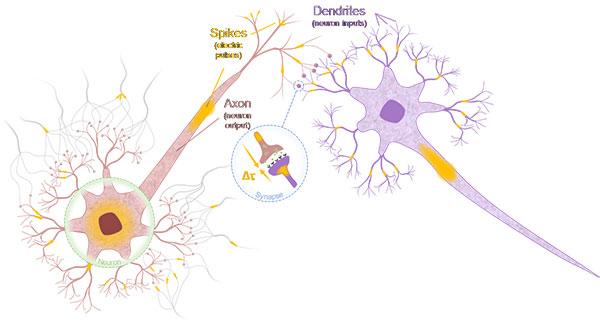Neuron and synapse-mimetic spintronics devices developed

This is a neuron and synapse in biological neural network. Credit: Aleksandr Kurenkov and Shunsuke Fukami
Today's information society is built on digital computers that have evolved drastically for half a century and are capable of executing complicated tasks reliably.
The human brain, by contrast, operates under very limited power and is capable of executing complex tasks efficiently using an architecture that is vastly different from that of digital computers.
So the development of computing schemes or hardware inspired by the processing of information in the brain is of broad interest to scientists in fields ranging from physics, chemistry, material science and mathematics, to electronics and computer science.
In computing, there are various ways to implement the processing of information by a brain. Spiking neural network is a kind of implementation method which closely mimics the brain's architecture and temporal information processing.
Successful implementation of spiking neural network requires dedicated hardware with artificial neurons and synapses that are designed to exhibit the dynamics of biological neurons and synapses.
Here, the artificial neuron and synapse would ideally be made of the same material system and operated under the same working principle. However, this has been a challenging issue due to the fundamentally different nature of the neuron and synapse in biological neural networks.
The research group – which includes Professor Hideo Ohno (currently the university president), Associate Professor Shunsuke Fukami, Dr. Aleksandr Kurenkov and Professor Yoshihiko Horio – created an artificial neuron and synapse by using spintronics technology.
Spintronics is an academic field that aims to simultaneously use an electron's electric (charge) and magnetic (spin) properties.
The research group had previously developed a functional material system consisting of antiferromagnetic and ferromagnetic materials. This time, they prepared artificial neuronal and synaptic devices microfabricated from the material system, which demonstrated fundamental behavior of biological neuron and synapse – leaky integrate-and-fire and spike-timing-dependent plasticity, respectively – based on the same concept of spintronics.
The spiking neural network is known to be advantageous over today's artificial intelligence for the processing and prediction of temporal information. Expansion of the developed technology to unit-circuit, block and system levels is expected to lead to computers that can process time-varying information such as voice and video with a small amount of power or edge devices that have the an ability to adopt users and the environment through usage.
Media Contact
All latest news from the category: Power and Electrical Engineering
This topic covers issues related to energy generation, conversion, transportation and consumption and how the industry is addressing the challenge of energy efficiency in general.
innovations-report provides in-depth and informative reports and articles on subjects ranging from wind energy, fuel cell technology, solar energy, geothermal energy, petroleum, gas, nuclear engineering, alternative energy and energy efficiency to fusion, hydrogen and superconductor technologies.
Newest articles

Silicon Carbide Innovation Alliance to drive industrial-scale semiconductor work
Known for its ability to withstand extreme environments and high voltages, silicon carbide (SiC) is a semiconducting material made up of silicon and carbon atoms arranged into crystals that is…

New SPECT/CT technique shows impressive biomarker identification
…offers increased access for prostate cancer patients. A novel SPECT/CT acquisition method can accurately detect radiopharmaceutical biodistribution in a convenient manner for prostate cancer patients, opening the door for more…

How 3D printers can give robots a soft touch
Soft skin coverings and touch sensors have emerged as a promising feature for robots that are both safer and more intuitive for human interaction, but they are expensive and difficult…





















